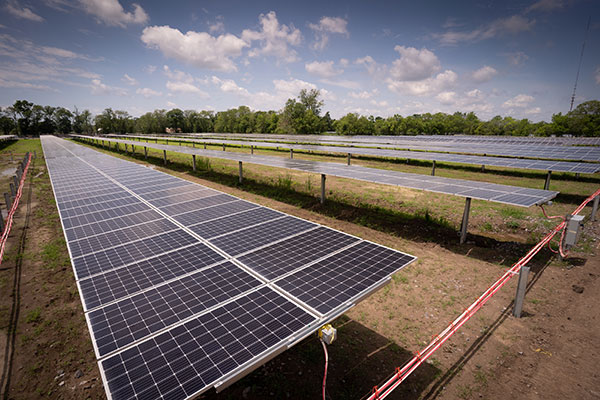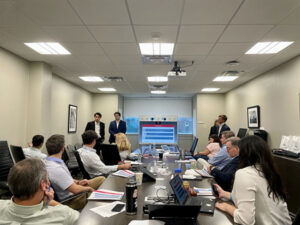
Capital Region Solar Power Generating Station, a 50-megawatt facility in West Baton Rouge Parish serving Entergy Louisiana customers.
Entergy Louisiana has been aggressively expanding its renewable portfolio to reduce the company’s carbon emissions and meet the demands of customers, but integrating solar into the power generation mix isn’t as easy as flipping a light switch.
“There are a lot of factors that impact the viability of solar here in Louisiana,” says Laura Beauchamp (BSM ’00, MBA ’04), director of resource planning and market operations with Entergy Louisiana.
To help Entergy get a better handle on those factors, Beauchamp reached out to Pierre Conner, executive director of the Tulane Energy Institute, and Conner connected Beauchamp with a team of students in his Energy Industry Projects course. Over the course of the spring 2023 semester, the students studied the impact of geographic diversification on solar reliability, analyzing locational and siting considerations with a focus on resource adequacy, energy adequacy and operating reliability.
“The students looked at hurricane risk, solar penetration and where we have existing infrastructure,” Beauchamp says. “What they were essentially attempting to do was smooth out a solar portfolio such that you could get the highest amount of solar generation during daylight hours.”
To accomplish that, the students — Ben Becnel, Garrett Ruiz, Sydney Miller and Hiram Young — analyzed 20 years of hourly weather data in 50 parishes across the state. Using Entergy Louisiana’s goal of delivering 3,000 megawatts of solar capacity in the next five years, the students hypothesized building six 500-megawatt facilities across the state.
The simplest approach would have been to choose the six parishes with the highest levels of solar radiation based on the weather data, but the students went a step further, identifying parishes with the most solar radiation exposure and then finding counterparts with the least hour-to-hour correlation over the 20-year period.
“What that tells us is that on any given day, at any given hour, if there’s rain or cloud cover in one parish — meaning there’d be no solar production — the other parish most likely has sunshine,” Ruiz explains. “It’s like hedging your bets.” The students also generated six-parish combinations of all 50 parishes in their set, teaching themselves Python to perform the statistical analysis necessary to calculate the Global Horizontal Irradiance (GHI) potential of each combination.
“It really gave me pause on how I think about my future portfolio,” Beauchamp says. “I typically have thought about siting generation closest to my load. It never really occurred to me that you can balance out average cloud cover, so it’s given us an opportunity to think about things differently and perhaps give more credit to facilities
that are in different parts of our state that we’ve not thought of before.”

Freeman students Garrett Ruiz, Hiram Young, Sydney Miller and Ben Becnel, left to right, present their report to Entergy Louisiana executives.
Ultimately, Ruiz says the study demonstrates the value of geographic diversification of solar assets, although he notes that the differences in hour-to-hour radiance across the state are not enough to impact power viability as long as there are sites located in at least four different parishes.
“This was actually the first class that I’ve taken that went outside the school,” says Miller, a senior pursuing a dual degree in economics and environmental studies. “Working closely with a company was super amazing, and also it’s applied learning, so what we were learning in the classroom we could contribute to the project. It was definitely a real-world experience.”
Ruiz, who now works as a power trading analyst for BP in Houston, says the project gave him an understanding of query languages he never could have gotten in a traditional class.
“I took an SQL course last semester, but until you get a task that has end goals, you don’t really learn as much as you could,” Ruiz says. “This project provided that.”
Perhaps the best thing about the project, Beauchamp says, is that it sets the stage for future collaborations.
“This was purely looking at solar output, not at costs,” she says. “It would be the perfect project to hand off to a new team that could take these findings and build the economic case to support these parishes.
“These students came to us with very robust understanding of not just the energy market, but how a utility can be a leader in the energy transition,” she adds. “Freeman’s focus on sustainability is exactly what we want coming out of universities and into our workforce.”

